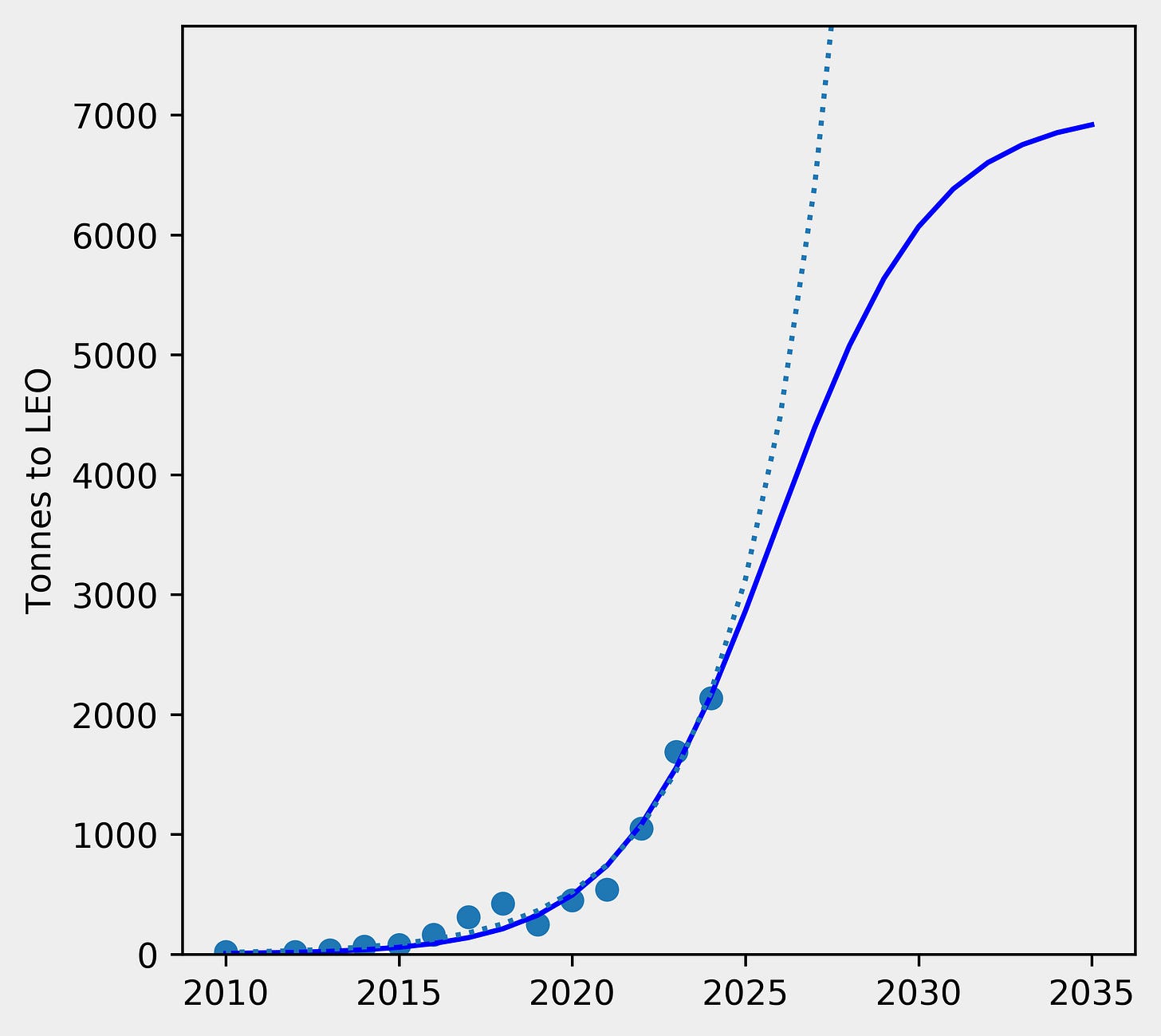Mass Value Report for April 2024
Falcon rockets continue to overperform, but are there doubts at NASA about the Starship cadence ramp?
There has been a lot of new information from SpaceX to digest into my models in the past month - the continuing extension of Falcon 9 lifetimes, a Starship update with some interesting data, and some noises from NASA suggesting that they may be preparing for Starship HLS not being ready in time for the Artemis III Moon landing.
First, something I wanted to introduce to my regular launch model is a more nuanced look at how I am measuring mass. The name of this series alludes to a paper I wrote in 2020 in the journal New Space. I saw some issues with using mass to LEO as a measure of capability, as it ignored the difficulties of travelling beyond Earth orbit and could not take account of in situ resources.
I’ve introduced SpaceX competitors into my modelling, and often they are sending more payloads into higher energy orbits - and if, as if often the case, they use more efficient upper stages, then simply measuring mass to LEO capability biases against them.
The above chart shows how, in the year 2022, ULA launched the majority of its payloads to high energy (Earth) orbits, whereas SpaceX launched mostly to LEO. The upper stages of both ULA rockets active at the time, Atlas V and Delta V, were liquid hydrogen/liquid oxygen stages with low dry masses. In comparison, Falcon 9 uses less efficient kerosene/liquid oxygen in its upper stage, and because it stages much earlier in order to give the booster a slow enough reentry to survive, that upper stage has a much higher dry mass once it reaches orbit due to the big empty tank.
This is a point that ULA themselves have been very keen to emphasise in their marketing materials, and they have been called out for not being entirely honest with their figures when doing so. Regardless, its important to be fair in doing this sort of analysis.
Before getting on to that, lets look at how Falcon rockets are getting on towards their cadence target.
Falcon Cadence
With 12 flights in April, SpaceX has made up for the slow start to the year, and are now on track for the 144 flights this year projected by Elon Musk.
The previous Mass Value Reports contained a mistake in calculating the error bars; I’ve gone back and simply removed them, leaving just the central estimate. That value has gone up from 134 to 144, although there is substantial uncertainty.
There is more good news for Falcon launches as well. This month has seen not one, but two boosters reach their 20th flight, which was once thought to be the limit - although one of them, B1060, was expended launching Galileo satellites for the European Space Agency. Ars Technica is reporting that each Falcon 9 booster will be certified for 40 flights which impacts the calculation on where the maximum cadence of Falcon 9 might be. There are rumours of a fourth drone ship being manufactured, which would be needed to support even further growth in Falcon 9 cadence.
If the booster manufacture rate continues at its recent average of about 10/year, then we would expect to see a shocking 400 flights/year. I am skeptical it will ever reach that though, as I think that Starship taking payloads (especially Starlink) from it will cap the flight rate. It is also worth noting that even this high target for Falcon 9 would not relieve that much pressure on Starship to continue the growth rate.
If the flights leveled off at 200 per year, there would have to be 6 Starship launches next year rising to 59 by 2028 to maintain growth rates. Leveling off at 400 would mean 3 Starship launches next year rising to 41 by 2028. These figures are not impossible but would require a very rapid ramp of Starship flight rates - simply because the pace set by the past few years is so rapid.
Falcon 9 has exceed all expectations. April also saw its 300th landing, and less than a decade ago people were still questioning if it could even be done at all. So perhaps a flight a day or more for this vehicle before it retires is not such an absurd notion.
Mass Value Growth Rate
The objective of space development is not, necessarily, just simply throw as much into LEO as possible. We want to colonise other planets, mine asteroids, and build free-floating cities at Lagrange points. We also want to live of resources that we find in space, and which are never launched into LEO.
For this reason I developed the metric of mass value. I explain the history and details of the concept here, but the short version is that mass value is The amount that would have to be placed into LEO to transport the mission payload to its final destination, using a standard basic method. For the simple case here, it imagines that all upper stages were replaced with the same low performance one - and calculates the mass of that booster. The benefits of using a higher energy stage are then automatically factored into the mass value metric.
Introducing corrected mass values for higher orbits, and adding in other providers, the overall mass picture looks like this, with Starship included at 50 tonnes to LEO/flight - reflected the payload of current prototypes.





